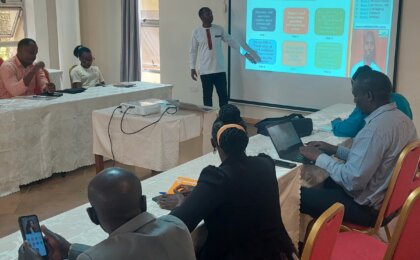Could the New Panty G-string-like Female Condom Save us?

Introduction
Well, if you didn’t know, soon you shall be able to look sexy in a lingerie for your man while at the same time providing yourself a contraception using one of the newest women’s panty condom! Manufactured by Innova Quality (a Colombian company), this knicker-like condom is an ‘underwear, thong (cotton or nylon) with a slit plus auto adhesive pocket containing one condom made of polyurethane for one time use (does not cause allergies, is transparent, odorless, solid, pre-lubricated)’
Many websites, including Daily Monitor, the Independent, and NTV keep referring to Innova Quality company and a website called female-condom.eu when describing this condom but my efforts to access these original sources were futile. When i browsed ‘female-condom.eu’, it didn’t turn up at all; it is like it doesn’t exist. And when i tried to search for Innova Quality, i was greeted with a very confusing landing page and couldn’t go any further. Try it all on your device and let me know what you find!

In Uganda, panty condoms were first talked about at least in 2015 few days after World Female Condom Day. Since then, Ugandans (both women and men) have been excitedly waiting for the ‘magic’ on the market.
In February 2018, the Independent reported that the condoms were already in the country undergoing some acceptability tests and then they would be enrolled onto the market in six-months time, which would have been October 2018. Additionally, Uganda National Council for Science and Technology had given a green light to the development. However, they (the condoms) never came out.
Latest developments reveal that, currently, everything is set and the condoms are most likely hitting our market in six-months time. According to Dr Moses Muwonge, the Executive Director SAMASHA Medical Foundation, a local non-profit promoting the condom, NDA has already approved the study to commence. The participants (women) for the study are already set. For now, count one up to six months, and hit your nearest supermarket for the sexy lingerie and panty condom!
About the PANTY Women’s Condom

As earlier noted, the website for the company Innova Quality was difficult to navigate. The other website (female-condom.eu) that many news websites cite isn’t available. Therefore, there is nowhere to get first-hand data regarding the product. A brief product sheet is available for download but not at the company’s site but at The Contraceptive Pipeline Database.
According to the promoter (Samasha medical foundation), “the condom is a combination of lingerie and a contraceptive made of polyurethane and intended for a one time use. It is anti-allergic and has been made with thinner than usual layer meant to make one have a no-condom feel”. Muwonge of Samasha adds that it “has a stronger material and allows for change of positions during intercourse unlike the current female condom on market. You can wear it all day and walk with it and when it comes for action, you don’t have to waste time putting it on”.
In a forum at Dr 1, an enthusiastic discussant cites Reuters about the condom in these words:
‘New Colombian condom to help quick, safe sex
BOGOTA, May 13 (Reuters) – A Colombian condom-maker has come up with a garment to help time-pressed lovers have safe sex without even taking their panties off. The so-called Panty Condom, trumpeted as the first of its kind, consists of lacy panties, in black or white, with an opening in the crotch. A thin resin membrane stuck to the inside of the underwear stretches like a condom. Bogota-based manufacturer Natural Sensation launched the condom-with-a-difference at a Bogota hotel late Wednesday. It is set to retail in Colombian supermarkets and pharmacies for about $3.60, including two spare membranes. The membranes are made of a resin called AT-10 rather than the latex used in traditional condoms. Inventor Max Abadi said the company aimed to sell 50,000 Panty Condoms this year — equivalent to about three percent of the national condom market. He is also eyeing what he hopes will be lucrative export markets in Central and South America’
During TV interview with NTV, Dr. Moses Muwonge asserted that the condom is affordable, easy to use and, yeah, stylish. A description at Face2FaceAfrica says the condom is in form of G-string and ‘combines contraception and lingerie, by incorporating a re-usable female condom into the garment’s design’. The website quote’s more of Muwonge’s explanations in these words:
“The pant is like a G-string which has a condom on it. It’s placed on the panty and has an inlet and outlet. When the lady is walking it does not affect the condom inside. It doesn’t require an initial positioning… it can be worn during the day… you can visit your boyfriend when the time comes and you can go to the toilet and wear your panty and come out looking sexy…”
Female Condom Use in Uganda
Female condoms were introduced in Uganda in 1998 when a ‘Fermidome’ also known as FC 1 was introduced. This condom wasn’t liked and was later stopped (2007) and replaced by FC 2 (2009) which, even though did better than the first one, still hasn’t captured the market. This is very unfortunate considering the fact that women are better than men in terms of health-seeking behaviors. A women’s favorite condom could turn around Uganda’s HIV and unwanted pregnancy situations!
Many studies that I have tried to review study condom use among female sex workers (FSWs) and not among general female population. A 2016 study on Makerere University female students unearthed that only 22.1% of the 1,008 young women knew about female condoms (Nsubuga et al., 2016). In 2018, New Vision cited a study by Makerere University school of public health in which 97% of Ugandans reported ignorance about how to use female condom (I have searched for this study in vain; Ugandan news sites don’t usually include links or references for the ‘lies’ they propagate!). A 2013 study on female sex workers and high-way truckers reported low consistent use of condoms for both male and female despite the 97% knowledge awareness regarding condom’s relevance in HIV prevention! (Matovu and Ssebadduka, 2013).
Some specific studies on female condoms demand have reported only 2% demand compared to 98% for male condoms. A 2017 detailed article at The Guardian highlights a waste of 1.2 million female condoms that had been procured and couldn’t be absorbed by women in Uganda! Women say the condoms look weird, are noisy during sex, require constant monitoring during sex, are difficult to put on or not user-friendly and, sometimes, expensive if acquired from private clinics.
Despite this low utilization of female condom among sex workers as well, it is always asserted that they (female sex workers) are the only group that has tried to use the condoms. This means that, among the general female population, uptake of female condom is a disaster. As quoted by All-Africa, hear Vastha Kibirige, the Condom Coordination Officer at Ministry of Health, who has been in the condom business for more than twenty years: Of the 240million condoms needed every year, only 2million is the current need for the female condom. “Women still find it weird. They say it’s hard to put on.”
Shall the panty female condom take Ugandans by storm?
According to the cited website of ‘ female-condom.eu’, the panty condoms are already on market and in use in Colombia, Panama, Costa Rica, Dominican Republic, Venezuela and Spain. I have tried to google ‘new panty women condoms use in Costa Rica’ and all those other countries and there is no relevant data. I kept replacing words, for example, female for women, panty-like for panty and uptake for use but still got no relevant data. Sorry.
However, for Uganda, wherever this same story has been published, Ugandans, in comments, keep asking, where can i find it? Is it already on market? How much is it? And so on! This, though sparsely, implies that Ugandans could really be excited about it. Let us wait and see!
Wouldn’t it be amazing if the new design catches up with women’s desires? Anyway, let us wait and see; let’s count the 1 up to 6 months and check in our supermarkets or nearest health centers!
NB: Also published at Life and Health Website
What do you think?
Some References
Nsubuga, H., Sekandi, J. N., Sempeera, H., & Makumbi, F. E. (2015). Contraceptive use, knowledge, attitude, perceptions and sexual behavior among female University students in Uganda: a cross-sectional survey. BMC women’s health, 16(1), 6.
Matovu, J. K., & Ssebadduka, N. B. (2013). Knowledge, attitudes & barriers to condom use among female sex workers and truck drivers in Uganda: a mixed-methods study. African health sciences, 13(4), 1027-1033.


